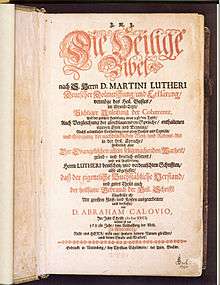Calov Bible
The Calov Bible is a three-volume 17th-century Bible that contains German translations and commentary by Martin Luther and additional commentary by Wittenberg theology professor Abraham Calovius.

Connection with J. S. Bach
The Calov Bible was made famous with the discovery of a long-lost copy that had once belonged to the composer Johann Sebastian Bach. At the time of his death, the inventory of Bach's library specified ownership of Calovii Schriften (writings of Calovius). It was not known until the 20th century what these writings were.
In June 1934 a Lutheran minister, Christian G. Riedel, was attending a convention of the Missouri Synod in Frankenmuth, Michigan. While a guest in the home of his cousin, Leonard Reichle, pastor Riedel was shown a volume of the Bible in which he recognized Bach's signature on the title page. Reichle subsequently located the other two volumes in his attic, relating that his family had purchased them in the 1830s, in Philadelphia. Reichle donated the three volumes to the Concordia Seminary Library in St. Louis, Missouri, in October 1938, and the Calov Bible is still there today. Only after the upheavals of World War II, however, did the bible become known to Bach scholarship.
The Calov Bible is in three volumes, each signed on its main title page by J. S. Bach, who followed his signature with the date, 1733.[1] These contain 348 underlinings, marks of emphasis, and marginalia in Bach's hand, an attribution that has been proven by handwriting analysis and chemical analysis of the ink. In many instances Bach was correcting typographical or grammatical errors. Three of Bach's more important notations are in proximity to the following passages. (Biblical passages, hyperlinked to biblegateway.com, are followed by Bach's comments).
- Exodus 15:20 -- “First prelude for two choirs to be sung to the glory of God.”
- I Chronicles 25 -- “This chapter is the true foundation of all God-pleasing church music.”
- II Chronicles 5:12-13 -- “In devotional music, God is always present with His Grace.”
References
External links
- Bach marginalia in Calov Bible contextualized in an analysis of the fugue in G-sharp minor from the Well-Tempered Clavier pdf or Shockwave
- Dr. Thomas Rossin's Youtube video on the history of the Calov Bible.